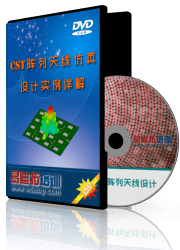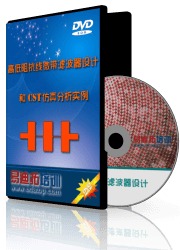- 易迪拓培训,专注于微波、射频、天线设计工程师的培养
CST2013 MWS Examples: Loaded Cavity (Team Workshop Problem 19)
Tetrahedral mesh:
Hexahedral mesh: |
|
Eigenmode and Q-factor: | |
External Q-factor: | |
Eigenmode and Q-factor: |

General Description
The eigenmode and Q-factor calculation of the team workshop example #19 ("Microwave Field in a Loaded Cavity") is presented. Furthermore the external Q-factor calculation is performed in the second example.
The structure mainly consists of an air filled cylinder containing a centered dielectric rod. In addition the cylinder is coupled by a small rectangular hole to a rectangular waveguide.
Structure Generation
The background material is defined as perfectly conducting material, the units are changed to millimeters, gigahertz and nanoseconds, and the boundary conditions are set to "electric" in order to model perfectly conducting walls. The structure is created by defining basic shapes like cylinders and bricks. Using the local coordinate system offers the possibility to create the shapes relative to each other.
For the external Q-factor calculation only the first eigenmode is of interest, thus the symmetry conditions for the XZ plane are set to "magnetic" and for the XY plane to "electric".
Mesh Settings
Both the number of lines per wavelength and the lower mesh limit are increased to 20 for the hexahedral mesh. Also for this mesh, in order to obtain accurate results the grid resolution is improved within the dielectric rod by defining the maximum mesh step width in x- and y-direction. Curved element order property for the tetrahedral mesh is set to 2.
Solver Setup
When the eigenmode solver is started, a specific number of the lowest resonance frequencies of the structure are calculated.
The relevant settings are defined using the default values, so that ten eigenmodes are considered.
Solver Setup (External Q)
The simulation is done by using the eigenmode solver JDM and activating the Calculate external Q-factor box. The solver then automatically calculates the first (unloaded) eigenmode, the corresponding external Q-factor and the loaded eigenmode.
Post Processing
The resulting mode information is listed in the navigation tree in the folder 2D/3D Results, subfolder Modes. Here the mode patterns as well as the corresponding eigenfrequencies can be found. The resonance frequencies are also stored in the logfile of the eigenmode solver.
The quality factors are calculated using Post Processing: 2D/3D Field Post Processing  Loss and Q
Loss and Q  .
.
In case of the external Q-factor calculation in addition the loaded eigenfrequency and external Q-factor are written in the logfile.
CST微波工作室培训课程套装,专家讲解,视频教学,帮助您快速学习掌握CST设计应用
上一篇:CST2013 MWS Examples: Waveguide Filter With Photonic Bandgap Material
下一篇:CST2013 MWS Examples: Waveguide Finline Transition
CST濠电偞鍨堕幖鈺呭储娴犲鍑犻柛鎰典簼閸犲棝鏌涢埄鍐х繁闁哄棎鍎甸弻娑㈠煛閸愮偓鏁銈嗘煥鐎氭澘顕i鈶╂瀻闁瑰瓨姊归悡锟� | More...
 最全面、最专业的CST微波工作室视频培训课程,可以帮助您从零开始,全面系统学习CST的设计应用【More..】
最全面、最专业的CST微波工作室视频培训课程,可以帮助您从零开始,全面系统学习CST的设计应用【More..】
频道总排行
- Rectangular Waveguide Tutorial
- FSS: Simulation of Resonator
- CST2013 MWS Examples: Thermal C
- Dipole Antenna Array - CST201
- CST MWS Examples - CST2013 M
- Microstrip Radial Stub - CST2
- Dielectric Resonator Antenna -
- Interdigital Capacitor - CST20
- CST2013 MWS Examples: Biological
- Lossy Loaded Waveguide - CST2










